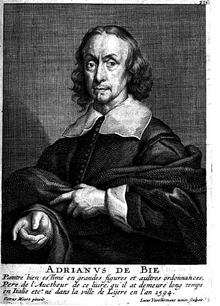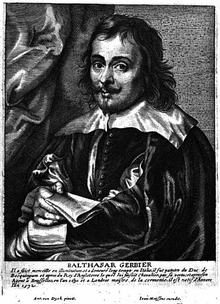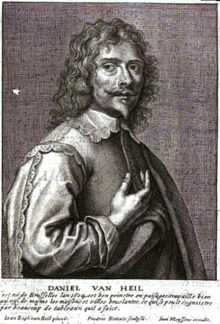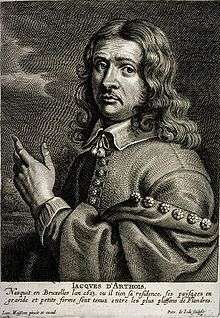Het Gulden Cabinet
 Title page of the Gulden Cabinet[1] | |
| Author | Cornelis de Bie |
|---|---|
| Country | Southern Netherlands |
| Language | Dutch |
| Subject | Artist biographies |
| Publisher | Jan Meyssen (1662) |
Publication date | 1662 |
Het Gulden Cabinet vande Edel Vry Schilder-Const or The Golden Cabinet of the Noble Liberal Art of Painting is a book by the 17th-century Flemish notary and rederijker Cornelis de Bie published in Antwerp. Written in the Dutch language, it contains artist biographies and panegyrics with engraved portraits of 16th- and 17th-century artists, predominantly from the Southern Netherlands. The work is a very important source of information on the artists it describes. It formed the principal source of information for later art historians such as Arnold Houbraken and Jacob Campo Weyerman. It was published in 1662, although the work also mentions 1661 as date of publication.
Background
Het Gulden Cabinet stands in a long tradition of artist biographies. This tradition goes back to Pliny and was revived during the Renaissance. In 1550, the Italian Giorgio Vasari published his Vite on the lives of famous artists. Karel van Mander was the first author to introduce this genre in the Dutch language with his Schilder-boeck of 1604. Cornelis de Bie explicitly placed himself in the tradition of van Mander and did what van Mander did for 15th and 16th Netherlandish artists for 17th-century artists.
In his Het Gulden Cabinet, de Bie presents himself as a rederijker whose duty it is to broadcast the fame of the artists. By doing so he followed an existing tradition already seen in Dominicus Lampsonius' 1572 Pictorum aliquot celebrium Germaniae Inferioris effigies and the Antwerp painter and rederijker Alexander van Fornenbergh's 1658 Antwerpschen Proteus ofte Cyclopschen Apelles, which sang the praises of the painter Quinten Matsys.
The concept of Het Gulden Cabinet did not come from Cornelis de Bie himself, but from the Antwerp printer Jan Meyssen. In 1649 Meyssen had already published Image de divers hommes, which contained engraved portraits of famous men, including painters, in imitation of Anthony van Dyck's Iconography. Most of the artist portraits in Het Gulden Cabinet are taken from this Image de divers hommes and only a few new engravings were made especially for de Bie's work.[2]
The work
General
The full title of the work is Het gulden cabinet vande edel vry schilder const: inhoudende den lof vande vermarste schilders, architecten, beldthouwers ende plaetsnyders, van dese eeuw, which translates as The Golden Cabinet of the Noble Liberal Art of Painting: Containing the Praise of the Most Famous Painters, Architects, Sculptors and Engravers of This Century. Despite its title, the book also deals with artists from the 16th century.
The work was dedicated to the Antwerp art collector Antoon van Leyen who had provided some of the information for the book and may also have helped finance the publication.[2][3] Other persons who had provided information on contemporary artists included de Bie’s own father, Erasmus Quellinus II, Luigi Primo and Hendrick ter Brugghen’s son Richard.[2]
Structure and style
The book has three parts. The first deals with artists who had died before de Bie's time and relies heavily on van Mander's Schilder-boeck. The second part deals with artists living at the time of de Bie and is mostly based on original research by de Bie and on the comments added to the engravings borrowed from Meyssens' Image de divers hommes. The third part deals with artists who had been omitted in the first two parts and also includes engravers, sculptors, architects, and painters.[4] A general treatise on the art of painting is woven into the entire work.[5]
The book is mainly written in verse, some of them in Latin, and is as a result rather difficult to read today. There are also some prose sections. It is over 500 pages long and contains engravings of more than 50 painters derived mainly from Meyssen's earlier work.
Influence
While The Gulden Cabinet never gained the level of popularity of van Mander’s Schilder-boeck, it is an important source of information on Flemish artists of the 17th century.[5] De Bie’s most important contribution was to provide a theoretical basis for his appreciation of (then) less valued painting genres such as still lifes, genre painting, portraits and landscapes. He unreservedly praised the artists who practised in these genres.[2]
Het Gulden Cabinet is included in the Basic Library of the Digital Library for Dutch Literature, which contains 1000 works of Dutch-language literature from the Middle Ages to today, which are deemed by its compilers to be of particular importance to Dutch-language literature.[6]
Second edition
De Bie seems to have planned a second edition of the work, but this was never published. The hand-written manuscript of de Bie is still extant and is kept at the Royal Library of Belgium. The manuscript is dated 1672. In it de Bie mentioned his intention to have a second edition published. The reason why the second edition was never published is unclear. It may have been due to the fact that the publisher and promotor of the first edition Jan Meyssen had died in 1670 and de Bie had difficulty finding another publisher.
Historical reliability
Like Vasari and Van Mander before him, de Bie's biographies are interspersed with amusing anecdotes. Although such literary motifs belong to a long rhetorical tradition, many of these stories were labelled "historically unreliable" by leading historians in the 19th century. Only recently have some of the stories been reinstated. Since the book was often the only surviving source of information on certain painters, these stories have often been repeated as hard facts about the lives of the painters described.
For instance, Cornelis de Bie postulates certain apprenticeships, which are now considered improbable because the pupil painted in a completely different genre than the teacher. De Bie's statement that Philips Wouwerman trained with Frans Hals was deemed implausible by later historians since Wouwerman painted landscapes with horses and Hals was principally a portrait painter. Some scholars still consider this apprenticeship as unlikely, but in view of Hals' large workshop it cannot be entirely excluded.
Artists in Het Gulden Cabinet, Part I
The engraved portraits included as illustrations in Book I are below, followed by the artists listed in order of appearance in the text. The first illustration is of Antoon van Leyen, to whom the book is dedicated.
 Anthoine van Leyen, page 9
Anthoine van Leyen, page 9 Cornelis de Bie, page 17
Cornelis de Bie, page 17 Adam van Oort, page 37
Adam van Oort, page 37 Octavio van Veen, page 39
Octavio van Veen, page 39 Abraham Bloemaert, page 45
Abraham Bloemaert, page 45 Tobias Verhaecht, page 47
Tobias Verhaecht, page 47.jpg) Adam Elsheimer, page 49
Adam Elsheimer, page 49 Guido Reni, page 52
Guido Reni, page 52 Rubens, page 57
Rubens, page 57 Frans Snyders, page 61
Frans Snyders, page 61 Willem van Nieulandt II, page 63
Willem van Nieulandt II, page 63 Anthony van Dyck, page 75
Anthony van Dyck, page 75 Gerard Segers, page 97
Gerard Segers, page 97 Adriaen van Utrecht, page 107
Adriaen van Utrecht, page 107 Adam Willaerts, page 111
Adam Willaerts, page 111 Johann Wilhelm Baur, page 113
Johann Wilhelm Baur, page 113 Nicolaes Knupfer, page 115
Nicolaes Knupfer, page 115 Jan van Bijlert, page 117
Jan van Bijlert, page 117.jpg) Jan van Balen, page 119
Jan van Balen, page 119 Roelant Savery, page 125
Roelant Savery, page 125.jpg) Henry van der Borcht the elder, page 127
Henry van der Borcht the elder, page 127 Jacob Adriaensz Backer, page 129
Jacob Adriaensz Backer, page 129- Deodat del Monte, page 133
 David Teniers I, page 141
David Teniers I, page 141 Adriaen van Nieulandt, page 147
Adriaen van Nieulandt, page 147 Alessandro Varotari, page 151
Alessandro Varotari, page 151 Peter Franchoys, page 153
Peter Franchoys, page 153 Jan Both, page 157
Jan Both, page 157 David Beck, page 161
David Beck, page 161 Gerard Honthorst, page 165
Gerard Honthorst, page 165 Thomas Willeboirts Bosschaert, page 167
Thomas Willeboirts Bosschaert, page 167.jpg) Bonaventura Peeters, page 171
Bonaventura Peeters, page 171 Frans Wouters, page 175
Frans Wouters, page 175
Artists in Het Gulden Cabinet, Part II
The engraved portraits included as illustrations in Book II are below, followed by the artists listed in order of appearance in the text. Book II begins on page 181.
- Daniel Seghers, page 213
 Pieter Snayers, page 221
Pieter Snayers, page 221.jpg) Jacob van Es, page 227
Jacob van Es, page 227 Adrian de Bie, page 231
Adrian de Bie, page 231.jpg) Adriaen van de Venne, page 235
Adriaen van de Venne, page 235 Jacques Jordaens, page 239
Jacques Jordaens, page 239- Gaspard de Crayer, page 245
 Balthasar Gerbier, page 249
Balthasar Gerbier, page 249 Leonard Bramer, page 253
Leonard Bramer, page 253 Cornelis van Poelenburch, page 257
Cornelis van Poelenburch, page 257 Erasmus Quellinus II, page 261
Erasmus Quellinus II, page 261 Jan Cossiers, page 267
Jan Cossiers, page 267 David Bailly, page 271
David Bailly, page 271 Herman Saftleven, page 275
Herman Saftleven, page 275 Jan van Bronkhorst, page 279
Jan van Bronkhorst, page 279 Abraham van Diepenbeeck, page 285
Abraham van Diepenbeeck, page 285 Pieter Danckerts de Ry, page 289
Pieter Danckerts de Ry, page 289 Daniel van Heil, page 293
Daniel van Heil, page 293 Cornelis Janssens, page 299
Cornelis Janssens, page 299 Jacques d'Arthois, page 301
Jacques d'Arthois, page 301 Pieter van Lint, page 307
Pieter van Lint, page 307 David Ryckaert, page 309
David Ryckaert, page 309 Nicolaes de Helt Stockade, page 313
Nicolaes de Helt Stockade, page 313 Gonzalo Coques, page 317
Gonzalo Coques, page 317 David Teniers II, page 335
David Teniers II, page 335 Robert van den Hoecke, page 341
Robert van den Hoecke, page 341 Jan Baptist van Heil, page 343
Jan Baptist van Heil, page 343 Jan Philips van Thielen, page 345
Jan Philips van Thielen, page 345 Petrus Meert, page 351
Petrus Meert, page 351 Jan Peeters I, page 355
Jan Peeters I, page 355 Petrus Boel, page 363
Petrus Boel, page 363 Jan van de Hecke, page 365
Jan van de Hecke, page 365_2.jpg) Hendrik van der Borcht II, page 383
Hendrik van der Borcht II, page 383 Jan Meyssens, page 387
Jan Meyssens, page 387 Jan van Kessel, page 411
Jan van Kessel, page 411
Artists in Het Gulden Cabinet, Part III
The engraved portraits included as illustrations in Book III are below, followed by the artists listed in order of appearance in the text. Book III begins on page 419.
 Coornhert, page 455
Coornhert, page 455 Hendrick de Keyser, page 459
Hendrick de Keyser, page 459 Jacob Franquart, page 479
Jacob Franquart, page 479 Egidius Sadeler, page 483
Egidius Sadeler, page 483 Hendrick Hondius, page 487
Hendrick Hondius, page 487 Petrus de Jode senior, page 493
Petrus de Jode senior, page 493 Paulus Pontius, page 497
Paulus Pontius, page 497 Lucas Faydherbe, page 499
Lucas Faydherbe, page 499 Artus Quellinus I, page 505
Artus Quellinus I, page 505- Petrus de Jode junior, page 511
 Jacques Callot, page 523
Jacques Callot, page 523 Leo van Heil, page 527
Leo van Heil, page 527 Petrus Verbrugghen, page 531
Petrus Verbrugghen, page 531 Simon Bosboom, page 547
Simon Bosboom, page 547.jpg) Wencelas Hollar, page 551
Wencelas Hollar, page 551 Artus Quellinus II, page 555
Artus Quellinus II, page 555.jpg) Steffano de la Belle, page 561
Steffano de la Belle, page 561
Notes
- ↑ The same title page was later re-used by S. Resta in his The True Effigies of the most Eminent Painters and other Famous Artists that have Flourished in Europe Curiously Engraven on 125 Copper Plates. London, 1694
- 1 2 3 4 Christiaan Schuckman. "Bie, Cornelis de." Grove Art Online. Oxford Art Online. Oxford University Press, accessed July 22, 2014
- ↑ Toon Houdt, On the Edge of Truth and Honesty: Principles and Strategies of Fraud and Deceit in the Early Modern Period, BRILL, 1 Jan, 2002, p 153
- ↑ Het Gulden Cabinet on Flandrica.be (Dutch)
- 1 2 Cornelis de Bie in the Dictionary of Art Historians
- ↑ Website of the Basic Library of the dbnl, the section on the Golden Age (Dutch)
References
- Digital version of the work on Google Books
- Digital version of the work on Erfgoedbibliotheek Hendrik Conscience
- G. Lemmens, "Introduction", in: Cornelis de Bie, Het Gulden Cabinet, Soest, 1971, p. 1-15 (reprint).
- Ch. Schuckman, "Did Hendrick ter Brugghen revisit Italy? Notes from an unknown manuscript by Cornelis de Bie." in: Hoogsteder-Naumann Mercury, 4 (1986), 7-22.
- P. Calu, "Tot verheffinghe der vermaerste Gheesten ende Lief-hebbers der Schildry. Literaire aspecten van Het Gulden Cabinet (1662) van Cornelis de Bie." in: "Spiegel der Letteren", 53 (1), 29-59.
| Wikimedia Commons has media related to Engraved portraits in Het Gulden Cabinet. |